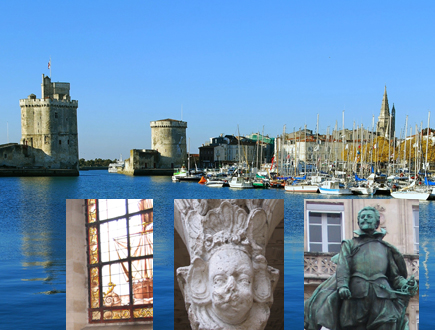
From spring to fall you might stay for two or three nights and include a half-day or full-day trip to the nearby islands, particularly Ile de Ré which can be reached from La Rochelle by car or bus (via a 1.8-mile bridge), or boat. The best way to explore the Ile de Ré is by bike, easily rented (inquire at Tourist Office). Boats from La Rochelle also go to the tiny island of Aix and the larger island of Oléron, with a view of Fort Boyard between the two. Boats are easily accessible as they leave from the Old Port at the center of La Rochelle.
A Brief History of La Rochelle
Willing to step into the English-French conflict of the Hundred Years War only far enough to secure its advantages, La Rochelle eventually became the largest French port along the Atlantic and remained so until the 15th century.
Another small museum, Musée Rochelais d’Histoire Protestante (La Rochelle Museum of Protestant History), recounts the influence and development of Protestantism in the region during the 16th and 17th centuries, when La Rochelle became one of a handful of pockets across France where the Reformation, having blown in from the east, took root and flourished. In 1570 La Rochelle became one of a four cities designated as Protestant strongholds in France, which allowed it significant independence with respect to dictates from the king and, naturally, from the Catholic Church. Nevertheless, a series of Wars of Religion between Catholics and Protestants marks the history of France in the second half of the 17th century.
City Hall dates from the heyday of Protestant La Rochelle at the turn of the 17th century, when Protestant-cum-Catholic Henri IV was king. A ceramic statue of the king, who had spent time here as a child and adolescent, stands above the courtyard.
The increasingly centralizing policies of (Henri IV’s son) Louis XIII and his Prime Minister (Cardinal) Richelieu sought to rein in La Rochelle’s independence and reassert royal, Catholic dominance in the Protestant strongholds. The Rochelais now found themselves caught between the French movement towards absolutism and the English desire to control trade along the coast. When the Rochelais failed to be sufficiently disturbed by the arrival of the English fleet on the nearby island of Ré, Louis XIII and Richelieu came in person to set French forces in place for the siege of La Rochelle. Jean Guiton, shown in defiance outside of City Hall (see photo inset), was elected mayor during the siege and inspired continued resistance to stand up to royal forces. But after 13 months of siege that had led to the starvation of 65-75% of the population and eliminated any hope that the English fleet would break through the blockade, the Rochelais surrendered.
La Rochelle then lost its privileges and its ramparts, and Catholicism was restored, but the town was physically spared, including its three main towers that can be seen today: the Chain Tower and the Saint Nicolas Tower at the entrance of the port (a chain was drawn across the two towers to prevent unwanted ships from entering the port) and further back the Lantern Tower, one of France’s oldest surviving lighthouses. The Great Clock Tower leads into the old town.
Within a decade after the siege the port had regained its sea legs. The town flourished through much of the 17th and 18th centuries, though two major ports just to the north (Nantes) and to the south (Bordeaux) new drew increasingly heavy traffic.
The digging of a new, deeper port in the late 19th century allowed La Rochelle to gain tonnage. That port was deep and useful enough that during WWII the Germans occupying the coast set up a submarine base here. La Rochelle’s fishing and commercial ports are now on the outer lip of the estuary, several miles from the Old Town, while a closer port called Les Minimes is given over to pleasure boats. Passenger boats for tours and transport to the nearby islands of Ré, Aix, and Oléron leave from the Old Port.
Meanwhile, the 20th century saw La Rochelle’s development as an important center for the rail industry. A rail yard in the works just before the outbreak of WWI proved to be ideally situated for the American arrival into the war in 1917. American ships brought with them locomotive and railway wagons packed in kits that were assembled here. The stately façade of the train station dates from the early 1920s. Over the ensuing decades, a vast suburban industrial site grew to produce trains and subways for use around the world.
The company now called Alstom took over the industrial site in 1972 and immediately set out to develop the TGV, Train Grande Vitesse, the high-speed that has ruled the rail lines of France since the early 1980s and is used in rail networks throughout the world.
PRACTICAL INFORMATION
Museums, Events, Links
Restaurants
Hotels
© 2008 by Gary Lee Kraut
Go to La Rochelle: A Winter Wanderbout in an Old Port Town, Part I: Night.
Or to La Rochelle: A Winter Wanderbout in an Old Port Town, Part II: Day.


I lived in the environs of La Rochelle when my father was stationed there in the late ’50’s. My mother is French (from the Pas de Calais region of France and also lived in Paris as a child). I wish there was more infor on the German occupation during the war as I understood they had a sub base in the area and I recall seeing a sunken ship with its hull upright in some harbor. I loved living there.
My grandmother was born and raised on the ile de re la rochelle..born in 1898 there. I would love more info about WW1 in that area……she came to the US after WW1 with my grandfather US soldier in that area.
ty…laura